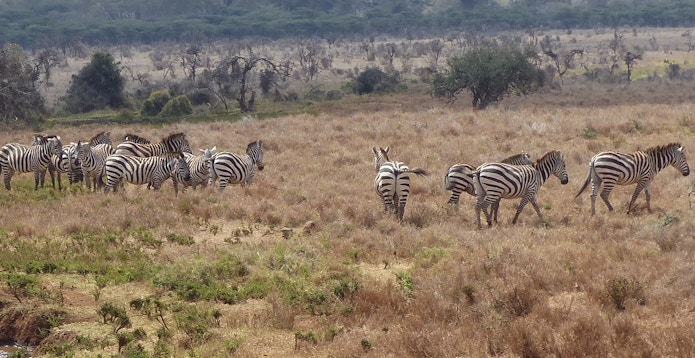Zebras and the Environmental Pressures on Social Behavior

How much do social relationships change in response to environmental pressures? Evolutionary biologist Kaia Tombak, now at Hunter College, has found that, for two species of zebras in central Kenya, their different grouping patterns give each species its own advantages and disadvantages. “The divergence in their social evolution is really what’s interesting to me,” she says. “Behavior is often seen as such a plastic trait, but it can still have a strong genetic basis. That makes it subject to evolution.”
Tombak studies the plains zebra (also known as the common zebra) and the endangered Grévy’s zebra, which have different social systems. Female plains zebras form a tight-knit group that will stick together and mate with a single male, who must ward off bachelor males seeking to win females. A Grévy’s zebra male, however, will defend a territory from other males while females come and go as they please, forming groups that may last for a few weeks or just a few hours. “Since the groups of Grévy’s zebra females don’t stay together, a male Grévy that uses a female-defense strategy may end up following just a single female around. But if he has a really good territory, then he has a chance of attracting a lot of females,” Tombak says. How these two different species evolved to have such different social patterns is the mystery that Tombak is looking to solve. An edited version of our interview follows.
First of all, considering that you don’t go out and tag them, what’s your secret for identifying individual zebras?
We use pattern-recognition software to ID animals, not unlike the biometric software that allows us to unlock our phones with our fingertips. Zebras are covered in unique patterns — after all, they are basically like walking fingerprints — so we can identify individuals based solely on their stripes. The software looks at places on the animal’s body where pixels transition quickly from black to white and finds unique regions, which it then matches from one image to another.
It’s super important to identify individuals because we want to see how group size and group behavior change from one day to the next.

What are the pressures that can influence socialization patterns?
There are many sources of selection on grouping patterns. Some are social: Harassment from bachelors can drive females to group with protective males, and relatedness is another selection force that can motivate individuals to group. However, zebras are interesting because they group together with non-kin, which is quite rare for mammals. There are also bottom-up forces based on the resources they depend upon. We knew before my study that plains zebras drink much more than Grévy’s zebras, which are better adapted to arid conditions because they evolved more in the Horn of Africa. But unfortunately for the plains zebras, grazing in areas close to water means grazing in areas with higher dung density and therefore more parasites, especially in the wet season.
And when you look at top-down forces like parasites and disease, which should discourage grouping because of transmission risk, and predation, which should encourage grouping for protection, it is possible that plains and Grévy’s zebras respond differently to these forces and evolved different degrees of group cohesion.
How do parasites affect zebras socially?
If disease transmission risk is an important selective factor acting on social behavior, it should encourage disaggregation, the evolution of smaller grouping tendencies. That’s something I really focused on in my Ph.D. because pathogen transmission is one of the least well-understood selection forces on social behavior in wild animals, and it’s a seasonally fluctuating pressure on zebras
One of the most prevalent pathogens they harbor are gastrointestinal nematodes, little worms in their guts. Almost every adult individual has them. So it’s a chronic infection that they have to deal with, but it’s an infection that surges in the wet season when nematodes start shedding a lot of eggs.
I analyzed fecal samples, and not only did I measure the number of eggs that the nematodes are shedding, but I also used genetic analyses to get the constellation of worm species that each individual zebra hosts. Because the zebras are pretty much all infected, zebra dung is almost always eggy. But plains zebras have more than Grévy’s zebras, likely because they are grazing in high-dung-density areas close to water. Dung density in their feeding grounds really matters.

So we need a big pooper scooper to help the zebras reduce their nematode loads?
Yes, in fact horse owners will often do this. Removing feces from the pasture regularly is one of the more effective ways to reduce infection. Horse owners may also use dewormers, but that’s one of the more controversial methods because, like with antibiotics, you can get resistant worms that are subsequently very difficult to control. However, for many animals in the wild, being chronically infected by worms is a natural state of affairs, and there are hypotheses that some level of nematode infection may in fact be beneficial.
Are zebras dying from nematode overload?
We don’t know. There are very few necropsies on wild zebras. By the time we get to them they’re usually half eaten. So it’s hard to know how exactly the parasites affect mortality rates, and it’s often a combination of factors that additively lead to mortality. For example, a high parasite load may make them weaker over time, and if they aren’t able to compensate with enough food, they may starve or become easy prey for lions.
So you would expect Grévy’s to have fewer nematodes than plains if they aren’t grazing in wet, dungy areas. Is that the case?
Grévy’s zebras, we discovered, also produce more immunoglobulin A (IgA), which might be one of the main ways they fight nematodes. IgA is an antibody that can have different roles. It can attack worms and lower their fecundity, for example, but it can also help to repair damaged tissue in the host. So it could be that Grévy’s are just dealing with the damage from the worms that they do have a little bit more actively using IgA. We don’t know if they are fighting harder or patching things up faster. But in any case, it seems Grévy’s are actively dealing with the nematodes through IgA more, and that could contribute to the lower egg counts.
Do the plains and Grévy’s zebras ever intermix?
If a dazzle of plains zebras cross the territory of a male Grévy’s zebra, he can overpower the dominant, but physically smaller, plains male and impregnate a female plains. The resulting hybrid colts will be raised in the plains zebra group, but they will have this weird split behavior that seems to suggest that they have some social traits from both sides of their heritage. Roughly half the hybrid sons become wandering, semiterritorial Grévy’s-like zebras, and half try to take over female groups and focus on defending them, despite very reduced fertility and sometimes sterility. So you have this crazy, almost Mendelian trait division based on genetic pushes and pulls between the two parent genes, although in reality it is surely a behavior influenced by many genes.
What have you learned from the hybrid zebras?
I have a specific study on the hybrids and how they deal with parasites because it gives us insight into the coevolutionary host-parasite arms race. We’re seeing some interesting patterns in their IgA and fecal egg counts compared to their parent species, giving us clues about how the parasites interact with a host when half the host genes come from one zebra species and the other half from the other zebra species. It’s yielded some surprises that are going to be coming out in a paper in the near future.
You recently moved from Princeton University to Hunter College, working in Jessica Rothman’s nutritional ecology laboratory. What is your focus there?
I’m rounding off some zebra projects through a different angle, because Dr. Rothman is an expert at looking at the ecological pressure of food resource availability from a super-fine-grained perspective. So now I am focusing on not only how and where is the food distributed, and how that affects the distribution of individuals, but also how the protein and the carbs and other nutrients are distributed. Using the detailed data that I collected, I used genetic analysis on fecal samples to see what plant genes show up in the dung. I’m now combining that with nutritional analyses of those grass species to see if the two zebra species are after the same nutrients or whether they are focusing on different nutrients and how that might affect their different feeding and social behaviors.
And I’ll be able to combine the nematode load with the nutritional data as well — protein intake seems to be an important factor for nematode resistance in many ungulate species.
Would you consider studying animals other than zebras?
Dr. Rothman actually focuses on mountain gorillas in Uganda — that’s another species with fascinating social behavior, and I would love to look at these same questions in that system!